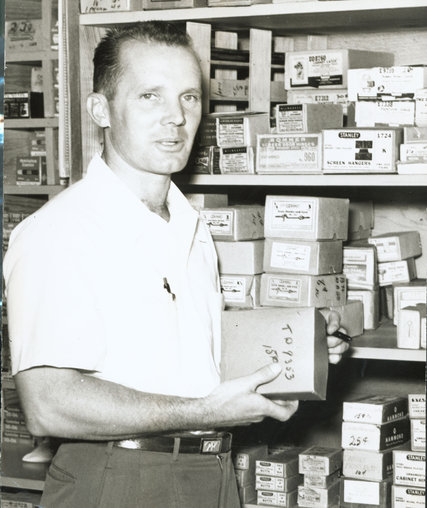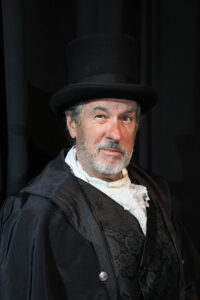Chuck Williams, the gourmet cookware retailer whose Williams-Sonoma empire began with a simple store in Sonoma, in 1956, died Sunday at age 100. Ten years ago, Sonoma’s Tom Rusert interviewed Williams on his 90th birthday. Here is the transcript of that interview as it appeared in The Sun on May 19, 2005.
TR: What started this all, was there a chef in the family… were you around the kitchen when you were young?
CW: My Grandmother was a very good cook, at least I thought she was. She did have the credentials because she had a restaurant when she was younger, in Ohio. I was born in northern Florida. My Grandmother had a restaurant and my Grandfather had a furniture store and they decided they wanted to move to Florida, so they bought a houseboat and they went down the inner rivers. My mother got married and I was born in 1915, and my grandparents were still on a houseboat. My Grandmother cooked three meals a day in those days, and my Grandfather loved to eat so she was always doing something. Every day was a certain procedure of cooking. Monday was washday, so cooking was a pot of beans. Tuesday was ironing day, so cooking was something else easy to do. Wednesday and Thursday was cleaning and cooking and baking. Friday and Saturday was all baking. She baked bread every week and pies and cakes and all that. I was in the kitchen quite a bit with her. I learned how to cook without recipes because my Grandmother never used them. I could make a stew or cook a pot of beans, roast or bake a ham and all that sort of stuff, though I never was much of a baker. When she was baking a pie, she would give me scraps of the dough and I would make little pies for myself.
TR: And you came to the town of Sonoma, California in 1947?
CW: After World War II in 1947. The reason I went to Sonoma is because I liked to build things. I decided I wanted to build a house all by myself. I wanted my contractor’s license. I was living in southern California when I came back from the war, but I really did not want to live there anymore. I visited a friend who lived in San Francisco and he wanted to go to Sonoma to play golf. I went along, Seeing Sonoma, I decided that was where I wanted to live. So, I moved there and built a house all by myself and did the plumbing, electrical and every thing. I got my contractor ‘s license, and for 10 years, I built houses.
TR: When did you make the leap and get into the retail business?
CW: In 1953 I took a trip to Paris and spent a lot of time going to department stores and shops and basically I always gravitated to cooking equipment. The wonderful pots and pans and baking equipment an d tools and so forth that were available to the French. This was not just for restaurants but was available to everyone. All the tools, all thegood knives, all the bakeware was available to both restaurants, and home cooks. In this Country there were two degrees of cooking equipment and tools, one for the restaurants and one for the home cook. The restaurant stuff you couldn’t get because it was only sold to restaurant supply. What was available to home cooks was at hardware stores and department stores, which were thin aluminum pots. Baking equipment was thin and tools were not very good. You could not buy a good knife, like a Henckel or anything. After seeing it in France, I though t why couldn’t we have this other stuff? Plus the fact that there was an interest in French cooking among the upscale people who traveled a lot during the two wars.
TR: So you bought a building to establish a new business on Broadway off the Plaza in Sonoma?
CW: The story goes that I bought a hardware store and added housewares. I did not do that. I did buy a building that had a hardware store in it, The Ralph Morris Hardware at 605 Broadway. I wanted the building to divide into small shops so I could have an income of rent. The only building I found that was on a good location for dividing up for small shops was this hardware store, and so I bought it. There was a driveway along side it and I added a section onto the building. One space I rented immediately to a Hawaiian woman that opened up a flower shop. In the beginning I thought, well, maybe I will just go along and reduce the inventory and it’ll just become a small hardware store in one of the spaces, but I said I couldn’t do what I really wanted to with a hardware store there. So I got rid of the hardware. I had a sale and what I didn’t sell, August Penelli, on the corner of the square, said bring the rest of it to me and I will buy it from you.
TR: Can you describe your first store in Sonoma, called Williams- Sonoma?
CW: It had bright yellow walls, black and white tile on the floor and white ceilings. It was very colorful and well-lit. The shelves that I built there were moved to the San Francisco store and were there for probably 35 years, at least. But the third and fourth stores still had shelving based on the originals.
TR: Do you remember the early products that were popular?
CW: The original idea for the store was, I wanted it to be French, really European. So I didn’t have any thing American. I had Desko from Belgium, which were enamel cast iron pots that later became Le Creuset; Russell Wright which was casual china and English Ironware. The business and inventory slowly grew; and in April 1958 I moved the store from Sonoma to San Francisco, on Sutter Street.
TR: Did Julia Child or James Beard or writers of the day influence what you stocked?
CW: Not really. I had already decided that I wanted a French kitchenware shop. In January of 1959, after I moved the shop to San Francisco, I took a trip to Paris and found out how I could buy merchandise. At first it was six of this, and two of that. I wanted to have a complete display of pots and pans, both copper and aluminum. At that time, they were heavy pots and pans for restaurant use. I had bakeware and also the French Pilco, which was ovenproof white porcelain , profess ional knives and tools. I didn’t just pick out one or two sizes, I got the whole thing. I couldn’t have been influenced by Julia Child because I already had a shop when she came out with her first cookbook in 1961.
TR: How about James Beard?
CW: James Beard I met the first year I was opened in San Francisco. He was there for some reason and he heard about the store. We became friends instantly, but I was never really influenced by writers. I opened the store, bought merchandise that I liked myself , and I didn’t go buying things thinking would people like this.
TR: When did you decide to introduce a retail catalogue?
CW: Well it was about 14 years later. The San Francisco store had remained a single store on Sutter Street for 17 or 18 years before we opened the second store in Beverly Hills. If you have a small retail business you never thought of starting something and exploding it into something big, as they do today. There weren’t many catalogues out at the time and it was small growing as was the store. I called my friend Eddie Marcus, who developed the Neiman Marcus catalogue. He also encouraged me to open the second store and incorporate.
TR: How were you introduced to balsamic vinegar?
CW: When I first saw it in Milan I didn’t know what it was. I was staying at a hotel across the street from the Milan Cathedral. Across the street was the La Rinascente Department Store. I would go to the seventh floor food department and cafe. I always went there to see what they had . One year I noticed these frosted bottles, labeled in Italian Aceto Balsamico. I didn’t speak Italian. It was a dark color inside and I did not know what it was. The next year I saw it again and asked what it was. It didn’t look like any old cider vinegar we had in America, so I bought a bottle and brought it home. It was good.
TR: In the new culinary products today; do you think functionality and design are coming together?
CW: I would say that a good bit of the designs are questionable. For example, some teakettle, saucepan or casserole dish can be questionable as far as functionality. There is a lot of it today I think; basically the idea is to increase the sell of something, so they try to design it better than what’s been in existence for the last 100 years.
TR: So here at Williams-Sonoma ‘s headquarters you have seen lots of changes. It’s a big operation from the handful of stores back in the beginning.
CW: Yes, it has changed considerably. I mean, starting a small business that remained a small kitchenware shop for 18 or 20 years, and never expecting it to be any thing other than that, because in those days there really wasn’t any way to have a second location. It wasn’t until the building of the shopping malls, where it became a necessity for small shops to multiply themselves. I think it sort of became about merchandising, too. Merchandise goes through long cycles of reinventing itself, and sooner or later it comes back to its origin. I had brought in Pilco, the white French porcelain, and I had the whole display for 50 years. The last couple years it has gone full cycle. It’s very functional and food looks better on white than any thing else, so it’s popular again .
TR: What are some of your favorite foods?
CW: Well I like roasted chicken. I must say that I love fish. Years ago, you only hadfish that was freshly caught where you lived, and in the middle of the country it was very difficult to get fish. It had to be well packed in ice. Salmon has certainly become a very popular fish and it’s very easy to prepare.
TR: What are you doing these days – shouldn’t you be fishing or sailing?
CW: Well, I should be retired. I will be 90 in October. They now have over 250 Williams-Sonoma stores in the U.S. and Canada and I have been editing all the cookbooks for the past 14 years, since 1991. I edit and proofread all the cookbooks, and that’s a lot of work. That’s about 140 cookbooks now. We have tried to make it easier for the home chef but it’s not always easy to do. If you say too much, it can become boring. They tend to like a list of short ingredients and also simple text to do it.
TR: And your reflections on Sonoma…
CW: Well, Sonoma still has a lot of its charm and character from the old days. Sonoma has been quite famous for its bakeries for over 70 years now, and also their cheese and wine industry goes way back. It’s changing some but I do very much enjoy spending time in Sonoma and Wine Country.






Excellent!